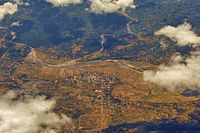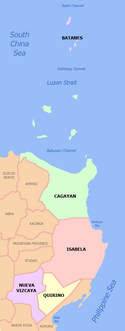
Quirino

Quirino | |
|---|---|
(from top: left to right) Part of Cagayan River in Quirino, Quirino Provincial Capitol, Aerial view of Maddela, Diffun town and Cabarroguis Town Hall. | |
| Nickname: Forest Heartland of Cagayan Valley | |
 Location within the Philippines | |
| Coordinates: 16°17′N 121°35′E / 16.28°N 121.58°E | |
| Country | Philippines |
| Region | Cagayan Valley |
| Founded | June 18, 1966 |
| Named for | Elpidio Quirino |
| Capital | Cabarroguis |
| Largest Municipality | Diffun |
| Government | |
| • Type | Sangguniang Panlalawigan |
| • Governor | Dakila Carlo E. Cua (PFP) |
| • Vice Governor | Julius Caesar S. Vaquilar (PDP–Laban) |
| • Representative | Midy N. Cua (Lakas–CMD) |
| • Legislature | Quirino Provincial Board |
| Area | |
| • Total | 2,319.66 km2 (895.63 sq mi) |
| • Rank | 54th out of 81 |
| Highest elevation | 1,808 m (5,932 ft) |
| Population (2020 census)[2] | |
| • Total | 203,828 |
| • Rank | 73rd out of 81 |
| • Density | 88/km2 (230/sq mi) |
| • Rank | 72nd out of 81 |
| Divisions | |
| • Independent cities | 0 |
| • Component cities | 0 |
| • Municipalities | |
| • Barangays | 132 |
| • Districts | Legislative district of Quirino |
| Time zone | UTC+8 (PHT) |
| ZIP code | 3400–3405 |
| IDD : area code | +63 (0)78 |
| ISO 3166 code | PH-QUI |
| Spoken languages | |
| Website | www |
Quirino, officially the Province of Quirino (Ilocano: Probinsia ti Quirino; Tagalog: Lalawigan ng Quirino), is a landlocked province in the Philippines located in the Cagayan Valley region in Luzon. Its capital is Cabarroguis while Diffun is the most populous in the province. It is named after Elpidio Quirino, the sixth President of the Philippines.

The province borders Aurora to the southeast, Nueva Vizcaya to the west, and Isabela to the north. Quirino used to be part of the province of Nueva Vizcaya, until it became a sub-province in 1966, then it was separated in 1972.

History
Early history
Long before its formal creation as an independent province, Quirino was the forest region of the province of Nueva Vizcaya, inhabited by tribal groups known as the Negritos. They roamed the hinterlands and built their huts at the heart of the jungle. Aside from the Negritos, the area was also inhabited by Ilongot people, who were feared for their headhunting raids against enemy tribes and Spanish-controlled settlements. Throughout the period of Spanish colonization, the province was one of the few remaining unconquered areas in the Philippines due to its remoteness, having only seen a Spanish military expedition in 1848 and the brief presence of Spanish missionaries in 1891.[3]


Colonial era
During the American period, the territory of Quirino was administered by the province of Isabela before Congressman Leon Cabarroguis of Nueva Vizcaya pushed for its return to Nueva Vizcaya by authoring Republic Act No. 236, which was signed into law in 1948.

Establishment as a separate province
On June 18, 1966, Republic Act No. 4734 was enacted, constituting the municipalities of Diffun, Saguday, Aglipay, and Maddela, all from Nueva Vizcaya province, into a new sub-province to be known as "Quirino", named after the late Philippine President Elpidio Quirino.[4][5] The reasons for naming it for Elpidio Quirino are the Ilocano settlers in the area and he created the neighboring province Aurora sub-province of Quezon in 1951 through Republic Act No. 648 under his presidency.

On June 21, 1969, Republic Act No. 5554 was enacted, amending RA 4734, and creating the municipality of Cabarroguis (now the provincial capital town), which was taken from portions of Diffun, Saguday, and Aglipay.[5][6]

Republic Act No. 6394, authored by then-Congressman Leonardo B. Perez (Nueva Vizcaya–Lone), was passed on September 10, 1971, further amending RA 5554 and separating the sub-province of Quirino from its mother province, Nueva Vizcaya, constituting it into a regular province.[5][7]

The province of Quirino was formally established on February 10, 1972, upon the assumption to office of the first elected provincial and municipal officials headed by Dionisio Sarandi as Provincial Governor.

On February 25, 1983, Batas Pambansa Blg. 345 was enacted, creating within Quirino the municipality of Nagtipunan, a division of the municipality of Maddela.[8]

Marcos dictatorship era
The beginning months of the 1970s marked a period of turmoil and change in the Philippines, as well as in the localities which would later become the Province of Quirino.

In February 1972, the efforts of Quirino's legislators finally managed to see its establishment as a separate province.[5][7]

During his bid to be the first Philippine president to be re-elected for a second term, Ferdinand Marcos launched an unprecedented number of public works projects that caused the Philippine economy to take a sudden downwards turn known as the 1969 Philippine balance of payments crisis, which led to a period of economic difficulty and social unrest.[9][10][11][12][13][14] With only a year left in his last constitutionally allowed term as president, Ferdinand Marcos placed the Philippines under martial law in September 1972 and thus retained the position for fourteen more years as a dictator.[15][16]

In Quirino, one of the most significant events of this period were the logging concessions in the areas of the Sierra Madre region awarded to various Marcos cronies, which marked the beginning of widespread deforestation and other environmental problems in the province.[17][18][19]

When the 1986 snap election came along, Quirino was noted as a site of political violence with the murder of UNIDO opposition party organizers Francisco Laurella and Fernando Pastor Sr., and Pastor's son Fernando Pastor Jr., later attributed to Marcos party-mate and Quirino province assemblyman Orlando Dulay, who was convicted of the three murders in 1990.[20][21][22][23]

Geography

Quirino covers a total area of 3,323.47 square kilometers (1,283.20 sq mi)[24] occupying the southeastern section of the Cagayan Valley region. A landlocked province, it is situated within the upper portion of the Cagayan River basin and bounded by Isabela on the north, Aurora on the east and southeast, and Nueva Vizcaya on the west and southwest.

The Sierra Madre mountain range provides a natural barrier on the eastern and southern border of the province and the Namamparang Range on the western part. The province is generally mountainous, with about 80 percent of the total land area covered by mountains and highlands. A large portion of the province lies within the Quirino Protected Landscape.

Climate
The province has a mean annual temperature of 33.6 °C (92.5 °F).[citation needed] June is generally the warmest month and the wettest months are March to August,[citation needed] with the rest of the year being neither too dry nor too wet. Heavy, sustained rainfall occurs from September to November.

| Climate data for Quirino | |||||||||||||
|---|---|---|---|---|---|---|---|---|---|---|---|---|---|
| Month | Jan | Feb | Mar | Apr | May | Jun | Jul | Aug | Sep | Oct | Nov | Dec | Year |
| Mean daily maximum °C (°F) | 27.4 (81.3) |
28.4 (83.1) |
29.6 (85.3) |
31.4 (88.5) |
32.2 (90.0) |
32.6 (90.7) |
32.0 (89.6) |
32.2 (90.0) |
32.0 (89.6) |
31.0 (87.8) |
29.6 (85.3) |
27.9 (82.2) |
30.5 (86.9) |
| Mean daily minimum °C (°F) | 20.0 (68.0) |
20.3 (68.5) |
21.4 (70.5) |
22.6 (72.7) |
23.5 (74.3) |
23.9 (75.0) |
24.0 (75.2) |
23.9 (75.0) |
23.5 (74.3) |
23.0 (73.4) |
22.4 (72.3) |
20.8 (69.4) |
22.4 (72.4) |
| Average rainy days | 15 | 12 | 12 | 9 | 13 | 13 | 15 | 14 | 16 | 14 | 18 | 15 | 166 |
| Source: Storm247 [25] | |||||||||||||
Administrative divisions
Quirino comprises 6 municipalities, all encompassed by a single legislative district.


|
| |||||||||||||||||||||||||||||||||||||||||||||||||||||||||||||||||||||||||||||||||||||||||||||||||||||||||||||||||||||||||||||||||||||
Barangays
The 6 municipalities of the province comprise a total of 132 barangays, with Gundaway (Poblacion) in Cabarroguis as the most populous in 2010, and Rang-ayan in Aglipay as the least.[27]

Demographics
| Year | Pop. | ±% p.a. |
|---|---|---|
| 1939 | 3,923 | — |
| 1948 | 2,520 | −4.80% |
| 1960 | 24,266 | +20.77% |
| 1970 | 49,767 | +7.44% |
| 1975 | 65,763 | +5.75% |
| 1980 | 83,230 | +4.82% |
| 1990 | 114,132 | +3.21% |
| 1995 | 131,119 | +2.63% |
| 2000 | 148,575 | +2.72% |
| 2007 | 163,610 | +1.34% |
| 2010 | 176,786 | +2.86% |
| 2015 | 188,991 | +1.28% |
| 2020 | 203,828 | +1.50% |
| Source: Philippine Statistics Authority[26][27][27] | ||
The population of Quirino in the 2020 census was 203,828 people,[2] with a density of 61 inhabitants per square kilometre or 160 inhabitants per square mile.

The major languages are Ilocano and Ifugao. Other languages are Bugkalot, Pangasinan, Kankana-ey, Tagalog, and English. As Quirino was part of Provincia de Cagayan which is the predecessor of Cagayan Valley, a few residents speak Ibanag, which was the lingua franca of Provincia de Cagayan before it was replaced by Ilocano.

The province also has the largest Igorot population next to its mother province Nueva Vizcaya outside the Cordillera region.

Religion
Quirino is predominantly Roman Catholic with 54 percent adherence[28] while Evangelicals and United Methodist Church serve as significant minorities with up to 20% of the population.[29] Some people still practice indigenous beliefs. Other religions such as the Iglesia ni Cristo (forming more than 9% of the province population),[30] mainline Protestant and Aglipayan are also well represented. Other religious groups are also have some minor adherents such as Islam.

Economy
Agriculture is the main industry in the province, with rice and corn as major crops.[39] These supply the demand of neighboring provinces and the metropolis. It is the leading producer of banana in the Cagayan Valley region.[39] Banana as well as banana chips are major products sold in Metro Manila and Pampanga. Small scale industries like furniture making, basketry, rattan craft, and dried flower production are prevalent.

Government
| District Representative | ||||
|---|---|---|---|---|
| Midy N. Cua | ||||
| Provincial Governor | ||||
| Dakila Carlo E. Cua | ||||
| Provincial Vice Governor | ||||
| Julius Caesar S. Vaquilar | ||||
| Provincial Board | ||||
| 1st District | Marlo S. Guillermo | Jovino F. Navalta | Marcelina M. Pagbilao | Babylyn G. Reyes |
| 2nd District | Linda G. Dacmay | Roy A. Saladino | Elizabeth B. Saure | Alegre M. Ylanan |
References
- ^ "List of Provinces". PSGC Interactive. Makati, Philippines: National Statistical Coordination Board. Archived from the original on January 17, 2013. Retrieved December 19, 2013.
- ^ a b c Census of Population (2020). "Region II (Cagayan Valley)". Total Population by Province, City, Municipality and Barangay. Philippine Statistics Authority. Retrieved July 8, 2021.
- ^ Salgado, Pedro. "What is now Quirino Province". Cagayan Valley and Easter Cordillera: 1581-1898, Volume II. Rex Publishing. pp. 906–911.
- ^ Republic Act No. 4734 (June 18, 1966), An Act Creating the Subprovince of Quirino in the Province of Nueva Vizcaya, retrieved January 13, 2015
- ^ a b c d "Brief History of Quirino". Province of Quirino (official website). Archived from the original on March 6, 2016. Retrieved January 13, 2015.
- ^ Republic Act No. 5554 (June 21, 1969), An Act Amending Republic Act Numbered Four Thousand Seven Hundred And Thirty-four, Entitled, "An Act Creating the Subprovince of Quirino in the Province of Nueva Vizcaya," and for Other Similar Purposes, retrieved January 13, 2015
- ^ a b Republic Act No. 6394 (September 10, 1971), An Act to Separate the Subprovince of Quirino from the Province of Nueva Vizcaya and Constitute It into a Regular Province to be Known as the Province of Quirino, retrieved January 13, 2015
- ^ Batas Pambansa Blg. 345 (February 25, 1983), An Act Creating the Municipality of Nagtipunan, in the Province of Quirino, retrieved January 13, 2015
- ^ Cororaton, Cesar B. "Exchange Rate Movements in the Philippines". DPIDS Discussion Paper Series 97-05: 3, 19.
- ^ Kessler, Richard J. (1989). Rebellion and repression in the Philippines. New Haven: Yale University Press. ISBN 0300044062. OCLC 19266663.
- ^ Celoza, Albert F. (1997). Ferdinand Marcos and the Philippines: The Political Economy of Authoritarianism. Greenwood Publishing Group. ISBN 9780275941376.
- ^ Schirmer, Daniel B. (1987). The Philippines reader : a history of colonialism, neocolonialism, dictatorship, and resistance (1st ed.). Boston: South End Press. ISBN 0896082768. OCLC 14214735.
- ^ Balbosa, Joven Zamoras (1992). "IMF Stabilization Program and Economic Growth: The Case of the Philippines" (PDF). Journal of Philippine Development. XIX (35). Archived from the original (PDF) on September 21, 2021. Retrieved November 6, 2022.
- ^ Balisacan, A. M.; Hill, Hal (2003). The Philippine Economy: Development, Policies, and Challenges. Oxford University Press. ISBN 9780195158984.
- ^ Magno, Alexander R., ed. (1998). "Democracy at the Crossroads". Kasaysayan, The Story of the Filipino People Volume 9:A Nation Reborn. Hong Kong: Asia Publishing Company Limited.
- ^ Robles, Raissa (2016). Marcos Martial Law: Never Again. Filipinos for a Better Philippines, Inc.
- ^ Danguilan Vitug, Marites (1993). The Politics of Logging: Power from the Forest. Manila: Philippine Center for Investigative Journalism. ISBN 978-971-8686-01-0.
- ^ Ricardo., Manapat (1991). Some are smarter than others : the history of Marcos' crony capitalism. New York: Aletheia Publications. ISBN 9719128704. OCLC 28428684.
- ^ REYES, RACHEL A. G. (October 18, 2016). "Marcos cronies and the golden oriole of Isabela". Archived from the original on November 8, 2020. Retrieved May 10, 2024.
- ^ "Marcos Follower Guilty of 3 Campaign Slayings". The L.A. Times. January 12, 1990. Retrieved February 21, 2020.
- ^ Pawilen, Reidan M. (May 2021). "The Solid North myth: an Investigation on the status of dissent and human rights during the Marcos Regime in Regions 1 and 2, 1969-1986". University of the Philippines Los Baños University Knowledge Digital Repository. Archived from the original on November 13, 2021. Retrieved May 22, 2022.
- ^ "MARTYRS AND HEROES: LAURELLA, Francisco "Frank" C." Bantayog ng mga Bayani. November 15, 2015. Retrieved February 21, 2020.
- ^ "MARTYRS AND HEROES: PASTOR Sr., Fernando T. – Bantayog ng mga Bayani". Bantayog ng mga Bayani. May 3, 2016. Retrieved May 18, 2018.
- ^ a b "Province: Quirino". PSGC Interactive. Quezon City, Philippines: Philippine Statistics Authority. Retrieved January 8, 2016.
- ^ "Weather forecast for Quirino, Philippines". Storm247.com. Bergen, NO: StormGeo AS. Retrieved April 21, 2016.
- ^ a b Census of Population (2015). "Region II (Cagayan Valley)". Total Population by Province, City, Municipality and Barangay. Philippine Statistics Authority. Retrieved June 20, 2016.
- ^ a b c Census of Population and Housing (2010). "Region II (Cagayan Valley)" (PDF). Total Population by Province, City, Municipality and Barangay. National Statistics Office. Retrieved June 29, 2016.
- ^ "MAP: Catholicism in the Philippines". Rappler. Archived from the original on June 22, 2018. Retrieved April 3, 2021.
- ^ "Archived copy" (PDF). Archived from the original (PDF) on January 14, 2014. Retrieved October 9, 2017.
{{cite web}}: CS1 maint: archived copy as title (link) - ^ "MAP: Iglesia ni Cristo in the Philippines". Rappler. Archived from the original on November 24, 2021. Retrieved April 3, 2021.
- ^ "Poverty incidence (PI):". Philippine Statistics Authority. Retrieved December 28, 2020.
- ^ "Estimation of Local Poverty in the Philippines" (PDF). Philippine Statistics Authority. November 29, 2005.
- ^ "2009 Official Poverty Statistics of the Philippines" (PDF). Philippine Statistics Authority. February 8, 2011.
- ^ "Annual Per Capita Poverty Threshold, Poverty Incidence and Magnitude of Poor Population, by Region and Province: 1991, 2006, 2009, 2012 and 2015". Philippine Statistics Authority. August 27, 2016.
- ^ "Annual Per Capita Poverty Threshold, Poverty Incidence and Magnitude of Poor Population, by Region and Province: 1991, 2006, 2009, 2012 and 2015". Philippine Statistics Authority. August 27, 2016.
- ^ "Annual Per Capita Poverty Threshold, Poverty Incidence and Magnitude of Poor Population, by Region and Province: 1991, 2006, 2009, 2012 and 2015". Philippine Statistics Authority. August 27, 2016.
- ^ "Updated Annual Per Capita Poverty Threshold, Poverty Incidence and Magnitude of Poor Population with Measures of Precision, by Region and Province: 2015 and 2018". Philippine Statistics Authority. June 4, 2020.
- ^ "2021 Full Year Official Poverty Statistics of the Philippines" (PDF). Philippine Statistics Authority. August 15, 2022. Retrieved April 28, 2024.
- ^ a b "The Province of Quirino". Department of Trade and Industry - Region 02. Archived from the original on February 21, 2020. Retrieved June 26, 2016.
External links
 Media related to Quirino (province) at Wikimedia Commons
Media related to Quirino (province) at Wikimedia Commons Geographic data related to Quirino at OpenStreetMap
Geographic data related to Quirino at OpenStreetMap- Official Website of the Provincial Government of Quirino
- Local Governance Performance Management System Archived March 4, 2016, at the Wayback Machine
See what we do next...
OR
By submitting your email or phone number, you're giving mschf permission to send you email and/or recurring marketing texts. Data rates may apply. Text stop to cancel, help for help.
Success: You're subscribed now !











